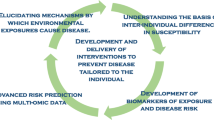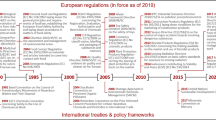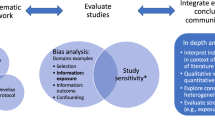Abstract
Measurement is the foundation of exposure science. Associations between illness and environmental agents have been observed for millennia, but the ability to quantify exposure and dose has been possible only in the last century. Improved means of measurement and refined concepts of who, what, when, where, and why to measure have been the seminal contributions of exposure science to the study of disease causation and prevention. This paper examines critical advancements in exposure assessment associated with workplace health and safety, and the groundbreaking work of the US Public Health Service. Many of the key concepts of modern exposure science have their origin in these early studies. Occupational hygiene scientists have conducted receptor-based exposure analyses for more than 80 years, evaluating indoor air, defining microenvironments, and developing personal sampling techniques. Biological monitoring of community populations including children, dermal exposure monitoring, duplicate diet studies, and multi-pathway, aggregate exposure assessments can be traced to early public health studies. As we look to the future, we see that new technologies and techniques are expanding the scope of exposure science dramatically. We need to ensure that the highest of scientific standards are maintained, make a greater effort to include occupational hygiene scientists, microbiologists, and behavioral scientists in the field, and promote new sources of training and research support. Exposure science has a critical role to play in the prevention strategy that is central to public health.
This is a preview of subscription content, access via your institution
Access options
Subscribe to this journal
Receive 6 print issues and online access
$259.00 per year
only $43.17 per issue
Buy this article
- Purchase on Springer Link
- Instant access to full article PDF
Prices may be subject to local taxes which are calculated during checkout







Similar content being viewed by others
References
Adgate J.L., Barr D.B., Clayton C.A., Eberly L.E., Freeman N.C., and Needham L.L., et al. Measurement of children's exposure to pesticides: analysis of urinary metabolite levels in a probability-based sample. Environ Health Perspect 2001: 109: 583–590.
Armstrong J.F., Wolfe H.R., Comer S.W., and Staiff D.C. Oral exposure of workers to parathion through contamination of food items. Bull Environ Contam Toxicol 1973: 10: 321–327.
Batchelor G.S., and Walker K.C. Health hazards involved in the use of parathion in fruit orchards of north central Washington. AMA Arch Ind Health 1954: 10: 522–529.
Carson R. Silent Spring. Houghton Mifflin Company, Boston, MA, 1962.
Cohen Hubal E.A., Sheldon L.S., Zufall M.J., Burke J.M., and Thomas K.W. The challenge of assessing children's residential exposure to pesticides. J Expo Anal Environ Epidemiol 2000: 10 (6 Pt 2): 638–649.
Cook W.A. Maximum allowable concentrations of industrial atmospheric contaminants. Ind Med 1945: 14: 936–946.
Curl C.L., Fenske R.A., Kissel J.C., Shirai J.H., Moate T.F., and Griffith W., et al. Evaluation of take-home organophosphorus pesticide exposure among agricultural workers and their children. Environ Health Perspect 2002: 110: A787–A792.
Davies D.J., Thornton I., Watt J.M., Culbard E., Harvey P.G., and Delves H.T., et al. Lead intake and blood lead in two-year-old U.K. urban children. Sci Total Environ 1990: 90: 13–29.
Davies J.E., Edmundson W.F., and Raffonelli A. The role of house dust in human DDT pollution. Am J Public Health 1975: 65: 53–57.
Drinker P., and Cook W.A. Maximum allowable concentrations of atmospheric impurities. J Ind Hyg Toxicol 1949: 31: 51–54.
Du J.N.H., and Oliver T.K. The baby in the delivery room. A suitable microenvironment. JAMA 1969: 207: 1502–1504.
Duan N. Stochastic microenvironment models for air pollution exposure. J Expo Anal Environ Epidemiol 1991: 1: 235–257.
Durham W.F., Armstrong J.F., and Quinby G.E. DDT and DDE content of complete prepared meals. Arch Environ Health 1965: 2: 641–647.
Durham W.F., and Wolfe H.R. Measurement of the exposure of workers to pesticides. Bull World Health Organ 1962: 26: 75–91.
Fenske R.A. Dermal exposure assessment techniques. Ann Occup Hyg 1993: 37: 687–706.
Fenske R.A., Wong S.M., Leffingwell J.T., and Spear R.C. A video imaging technique for assessing dermal exposure. II. Fluorescent tracer testing. Am Ind Hyg Assoc J 1986: 47: 771–775.
Franklin C.A. Estimation of dermal exposure to pesticides and its use in risk assessment. Can J Physiol Pharmacol 1984: 62: 1037–1039.
Harris R.L. The wheel of change. J Expo Anal Environ Epidemiol 1994: 4: 413–425.
Kallet A., and Schlink F.J. 100,000,000 Guinea Pigs: Dangers in Everyday Foods, Drugs and Cosmetics. Grosset & Dunlap Publishers, New York, 1933.
Kissel J.C. The mismeasure of dermal absorption. J Expo Sci Environ Epidemiol 2010 (in press).
Lacey R.F., Moore M.R., and Richards W.N. Lead in water, infant diet and blood: the Glasgow Duplicate Diet Study. Sci Total Environ 1985: 41: 235–257.
Lamb R.D. American Chamber of Horrors. Farrar and Rinehart Incorporated, New York, 1936.
Lanphear B.P., and Roghmann K.J. Pathways of lead exposure in urban children. Environ Res 1997: 74: 67–73.
Lees P.S., Corn M., and Breysse P.N. Evidence for dermal absorption as the major route of body entry during exposure of transformer maintenance and repairmen to PCBs. Am Ind Hyg Assoc J 1987: 48: 257–264.
Loewenherz C., Fenske R.A., Simcox N.J., Bellamy G., and Kalman D. Biological monitoring of organophosphorus pesticide exposure among children of agricultural workers in central Washington State. Environ Health Perspect 1997: 105: 1344–1353.
McKone T.E. Household exposure models. Toxicol Lett 1989: 49: 321–339.
Melnyk L.J., Berry M.R., and Sheldon L.S. Dietary exposure from pesticide application on farms in the Agricultural Health Pilot Study. J Expo Anal Environ Epidemiol 1997: 7: 61–80.
Moschandreas D.J. The whence, wherefore and whither of the new scientific discipline of environmental inquiry: exposure analysis (The 2002 Wesolowski Lecture). J Expo Anal Environ Epidemiol 2003: 13: 247–255.
Needleman H.L., and Landrigan P.J. The health effects of low level exposure to lead. Annu Rev Public Health 1981: 2: 277–298.
NIOSH. Report to Congress on Workers’ Home Contamination Study Conducted Under the Workers’ Family Protection Act (29 U.S.C. 671 A). National Institute for Occupational Safety and Health, Washington, DC, 1995.
NIOSH. r2p: research to practice at NIOSH. National Institute for Occupational Safety and Health. Accessed 3 March 2010: http://www.cdc.gov/niosh/r2p/.
NRC. Risk Assessment in the Federal Government: Managing the Process. National Academies Press, Washington, DC, 1983.
NRC. Human Exposure Assessment for Airborne Pollutants: Advances and Opportunities. National Research Council, National Academy Press, Washington, DC, 1991.
NRC. Pesticides in the Diets of Infants and Children. National Academies Press, Washington, DC, 1993.
Ott W.R. Total human exposure: an emerging science focuses on humans as receptors of environmental pollution. Environ Sci Technol 1985: 19: 880–886.
Palmer R.L., and Isidore M.A. 40,000,000 Guinea Pig Children. The Vanguard Press, New York, 1937.
PSAC. Restoring the Quality of our Environment. Report of the Environmental Pollution Panel, President's Science Advisory Committee, The White House, Washington, DC, 1965.
Quackenboss J.J., Krzyzanowski M., and Lebowitz M.D. Exposure assessment approaches to evaluate respiratory health effects of particulate matter and nitrogen dioxide. J Expo Anal Environ Epidemiol 1991: 1: 83–107.
Roberts J.W., Budd W.T., Ruby M.G., Bond A.E., Lewis R.G., and Wiener R.W. et al. Development and field testing of a high volume sampler for pesticides and toxics in dust. J Expo Anal Environ Epidemiol 1991: 1: 143–155.
Roberts J.W., and Dickey P. Exposure of children to pollutants in house dust and indoor air. Rev Environ Contam Toxicol 1995: 143: 59–78.
Roberts J.W., Wallace L.A., Camann D.E., Dickey P., Gilbert S.G., and Lewis R.G., et al. Monitoring and reducing exposure of infants to pollutants in house dust. Rev Environ Contam Toxicol 2009: 201: 1–39.
Roff M.W. Accuracy and reproducibility of calibrations on the skin using the fives fluorescence monitor. Ann Occup Hyg 1997: 41: 313–324.
Santolucito J., Ed.) Proceedings of the International Workshop on Exposure Monitoring. University of Nevada, Las Vegas, NV, 1982.
Schlink F.J. Eat, Drink and Be Wary. Covici Freide Publishers, New York,, 1935.
Sexton K., Letz R., and Spengler J.D. Estimating human exposure to nitrogen dioxide: an indoor/outdoor modeling approach. Environ Res 1983: 32: 151–166.
Sexton K., Kleffman D.E., and Callahan M.A. An introduction to the National Human Exposure Assessment Survey (NHEXAS) and related phase I field studies. J Expo Anal Environ Epidemiol 1995: 5: 229–232.
Shatkin J.A., and Brown H.S. Pharmacokinetics of the dermal route of exposure to volatile organic chemicals in water: a computer simulation model. Environ Res 1991: 56: 90–108.
Sheldon L.S., Keever J.T., Roberds J.M., Beach J.B., and Morgan J.N. Method for measuring base/neutral and carbamate pesticides in personal dietary samples. J Expo Anal Environ Epidemiol 1997: 7: 37–59.
Sherlock J.C., Lindsay D.G., Hislop J.E., Evans W.H., and Collier T.R. Duplication diet study on mercury intake by fish consumers in the United Kingdom. Arch Environ Health 1982: 37: 271–278.
Sherwood R.J., and Greenhalgh D.M.S. A personal sampler. Ann Occup Hyg 1960: 2: 127–132.
Sherwood R.J. On the interpretation of air sampling for radioactive particles. Am Ind Hyg Assoc J 1966: 27: 98–109.
Simcox N.J., Fenske R.A., Wolz S.A., Lee I.C., and Kalman D.A. Pesticides in household dust and soil: exposure pathways for children of agricultural families. Environ Health Perspect 1995: 103: 1126–1134.
Smith K.R. Air pollution: assessing total exposure in developing countries. Environment 1988: 30 (8): 11 & 30(10):17.
Smith K.R. Place makes the poison (Wesolowski Award Lecture—1999). J Expo Anal Environ Epidemiol 2002: 12: 167–171.
Smyth H.F. Suggested modifications of the standard method for the study of the dust content of air. Am J Public Health (NY) 1918: 8: 769–771.
Spengler J.D., and Sexton K. Indoor air pollution: a public health perspective. Science 1983: 221: 9–17.
Teleky L. History of Factory and Mine Hygiene. Columbia University Press, New York, 1948.
Thomas K.W., Sheldon L.S., Pellizzari E.D., Handy R.W., Roberds J.M., and Berry M.R. Testing duplicate diet sample collection methods for measuring personal dietary exposures to chemical contaminants. J Expo Anal Environ Epidemiol 1997: 7: 17–36.
US Congress. The Food Quality Protection Act. Public Law 104–170, United States Congress, Washington, DC, 1996.
USEPA. General Principles for Performing Aggregate Exposure and Risk Assessments. Item 6043. Office of Pesticide Programs, US Environmental Protection Agency, Washington, DC, 2001.
USPHS. A Study of the Effect of Lead Arsenate Exposure on Orchardists and Consumers of Sprayed Fruit. US Public Health Service, Public Health Bulletin No. 267, US Government Printing Office, Washington, DC, 1941.
Van de Sandt J.J., Dellarco M., and Van Hemmen J.J. From dermal exposure to internal dose. J Expo Sci Environ Epidemiol 2007: 17 (Suppl 1): S38–S47.
Wallace L.A. The Total Exposure Assessment Methodology (TEAM) Study: Summary and Analysis: Volume 1. US Environmental Protection Agency Office of Research and Development, Washington, DC, 1987.
Wallace L.A. Comparison of risks from outdoor and indoor exposure to toxic chemicals. Environ Health Perspect 1991: 95: 7–13.
Whorton J Before Silent Spring: Pesticides and Public Health in Pre-DDT America. Princeton University Press, Princeton, NJ, 1974.
Winter C.K. Dietary pesticide risk assessment. Rev Environ Contam Toxicol 1992: 127: 23–67.
Wolfe H.R., Armstrong J.F., Staiff D.C., and Comer S.W. Potential exposure of workers to parathion through contamination of cigarettes. Bull Environ Contam Toxicol 1975: 13: 369–376.
Zartarian V.G., Ozkaynak H., Burke J.M., Zufall M.J., Rigas M.L., and Furtaw Jr E.J. A modeling framework for estimating children's residential exposure and dose to chlorpyrifos via dermal residue contact and nondietary ingestion. Environ Health Perspect 2000: 108: 505–514.
Acknowledgements
This paper is based on the 2007 Wesolowski Award Lecture, presented at the annual meeting of the International Society of Exposure Science in Durham, North Carolina. I express deep appreciation to society members for selecting me for this award. I especially acknowledge all of the students, research scientists, and colleagues who have worked with me over the years; they have contributed immensely to the body of work we can draw on in the exposure science field. Thanks also to the guidance provided by my doctoral studies advisor, Dr. Robert Spear, and for the mentoring I received from the late Dr. Jerome Wesolowski when I worked for a short time in his laboratory in Berkeley, California in the early 1980s.
Author information
Authors and Affiliations
Corresponding author
Ethics declarations
Competing interests
The authors declare no conflict of interest.
Rights and permissions
About this article
Cite this article
Fenske, R. For good measure: Origins and prospects of exposure science (2007 Wesolowski Award Lecture). J Expo Sci Environ Epidemiol 20, 493–502 (2010). https://doi.org/10.1038/jes.2010.26
Received:
Accepted:
Published:
Issue Date:
DOI: https://doi.org/10.1038/jes.2010.26



